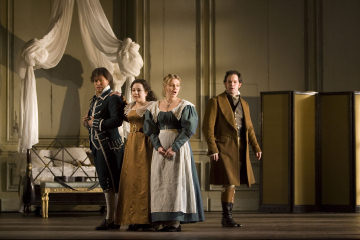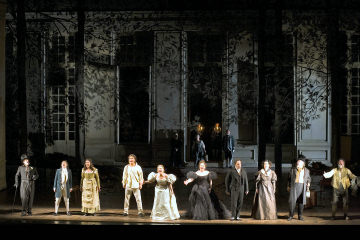|
Editor:
Marc Bridle
Webmaster: Len Mullenger
|
Seen and Heard Opera Review Mozart, Le Nozze
di Figaro, The Royal Opera House, Covent Garden,
2.2.2006 (ME)
Covent Garden’s anniversary production could just as well have been called Le Nozze d’il Conte, at least in musical terms, since it was only in Gerald Finley’s stylish account of that role, and arguably in the performance of his henchman Basilio by Philip Langridge, that we heard truly world class singing. This is a particularly autocratic Count, not above some rough treatment both of his equals and his inferiors, and it is not just the mixture of hauteur in the characterization and beauty of line in the singing that make him a paradoxically sympathetic figure. Finley is always a tower of strength in ensemble, and here Esci, ormai, garzon malnato launched the Act II finale superbly: Hai gia vinta la causa was as finely sung as I’ve ever heard it, despite having to compete with an onstage retinue – but more of that later.
Langridge is an equally fine Mozartian and it was a pleasure to hear him in this relatively minor part – he too is telling in ensemble, his utterances of Cosi fan tutte le Belle delightfully pointing up the situation in the discovery scene. His portrayal seemed to have wandered in from the entourage of fops in the same director’s Zauberflöte; appropriate in this context of course, although I was perturbed to read that one critic found his depiction a nastily camp echo of his Aschenbach, to me not at all a ‘camp’ assumption.
Basilio was supported by an outstanding Bartolo in Jonathan Veira and a Marcellina (Graciela Araya) who for once gave the impression that she could rival Susanna as the object of a young man’s affections. Ana James was making her Royal Opera debut as Barbarina, and it was a notable one from this fine young singer whose Queen of the Night impressed me at the RCM.
Erwin Schrott
(Figaro) Dorothea Röschmann (Countess Almaviva) It’s all downhill from there, at least in terms of the level one might have expected in this house at this time. Erwin Schrott’s Figaro is Bryn Terfel, only fourteen: this is a wonderful natural voice, a real ‘base barreltone’, but it is mostly used for shouting, mugging and muttering. Tutto è tranquillo e placido gave hints of what his singing could become, with discipline. His Susanna was the very pretty Miah Persson, who sang nicely but without any special distinction. Rinat Shaham was a positively irritating Cherubino, with a whole wardrobe full of physical tics, and I found her voice too light for the part.
I was very surprised that Dorothea Röschmann was singing the Countess: I thought her voice too light, and on this showing I was not mistaken. She was not helped by the director’s neurotic concept of her role, which robbed her of all her pathos and dignity: rushing on breathlessly to sing Porgi Amor is hardly appropriate for an aria conceived as a prayer to Eros, offered up in the quiet of her lonely sanctuary. Dove sono was sung with anxiety rather than longing, and the lovely creamy legato lines which should characterize this aria were absent – di dolcezza, e di piacer should be sung in one fluent arc of sound, not with a snatched breath in the middle, although such phrasing might well have been dictated by the production.
With what do you associate Spain? Sun perhaps, light, mañana – but certainly colour above all, and there was precious little of that onstage. It was as if Spain had had all its colour leeched out, leaving only a wash of inoffensive sludge. Yes, I did take the point that the scene had been ‘updated’ to a French Château in the eighteen-thirties, but since this failed to illuminate anything very much, one could only ask, what for? I had been wondering where I’d last seen the line of windows which dominate Act I, and it dawned on me that they were just like the ones which graced Faninal’s palace in Miller’s ENO Rosenkavalier, although where Faninal’s were sparkling, the glass at Aguas Frescas was clearly in need of a few spurts of Windolene – really, what were those sixteen servants up to when they’d finished swishing their brooms about? Figaro and Susanna’s room looked rather like Rigoletto’s home in McVicar’s ROH production, and one might have wondered why Figaro needed to measure the space for the bed since it was already attached to the wall.
The lighting (Paule Constable) was beautiful in its subtlety, and there were one or two nice touches such as the intricate ‘generator’ with which the Count was toying at the start of Act III , but overall the production was safe rather than enlightening, missing out on many of the music’s most delectable moments. For example, Susanna and Marcellina’s ‘No, you first’ scene should be a combination of the sweet interweaving of their voices and the bitchy gesturing at the door, but here it went for nothing: when the Duke comes back ready to break down the door in Act II, he remarks that all is exactly as he left it – but of course it isn’t, and that’s the joke, but here it fell flat.
I found Act IV quite insulting, to be frank. There was no garden to speak of, just knocked over bits of furniture and a fragile screen of leaves and a few suggestions of trees – where were those shaky pavilions, those pinprick stars, that dark blue sky, those looming cypresses? These are not idle questions since in Mozart’s time a garden was a place where nature was tamed and ordered according to the rules of harmony, against the backdrop of which reason triumphs over passion: I’m afraid a couple of thrown about chairs and a few slender poles just aren’t good enough.
Antonio Pappano directed the orchestra from the harpsichord, although his contributions to the recitatives were workmanlike rather than witty: the orchestra played well for him but in keeping with everything else this was a muted rather than effervescent account. I’m sure this production will be seen by my grandchildren, and that critics then will greet it with comments like ‘It looks as good as ever’ since it is bland, middle of the road and ultimately unexciting.
Back to the Top Back to the Index Page |
| ||
|
||||





